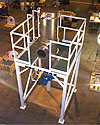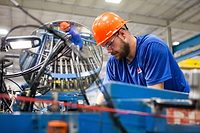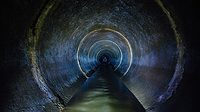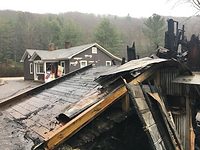Sweeping Dust and Debris Could Blow Your Safety Rating

Sweeping or blowing of fugitive dust during housekeeping is widely discouraged by OSHA and the NFPA for nearly all industries. Seemingly benign, dusts create an assortment of hazards that include flying particles that can lead to eye injury, slip hazards and ergonomic injuries. The most serious hazards surrounding the sweeping and blowing of dust threaten lives – i.e., respiratory and explosion hazards. The use of vacuums to remove dust is almost always recommended as a preferred method of removing fugitive dust. Rather than redistributing dust, industrial vacuum cleaners remove dust and, therefore, reduce or eliminate the previously mentioned hazards.
Certainly, the most dramatic hazard associated with dust is secondary explosion. This is so dramatic that it captured the attention of Congress, which led to a bill that directed OSHA to “issue an interim combustible dust rule and an amendment to the Hazard Communication Standard (HCS) in 90 days, and a final rule in 18 months,” according to OSHA’s Combustible Dust; Advance notice of proposed rulemaking.
With over 4,900 violations associated with OSHA’s Com-bustible Dust National Emphasis Program (NEP), recent news releases about the organization leveling fines at four companies ranging from $63,000 to $137,000 this year alone, and increasing local television coverage of combustible dust violations, it should now be clear that OSHA is serious about enforcing current standards.
In response to OSHA’s NEP, many facility and safety managers have revamped their housekeeping practices and added industrial vacuum cleaners approved for use in Class II, Div II areas to mitigate the possibility of secondary explosions caused by fugitive dust. However, of the over 1,000 inspections that OSHA has completed, only 18 to 22 percent of the facilities were in compliance with OSHA requirements.
“It can sometimes be tough for facilities,” says David Kennedy, GM for VAC-U-MAX’s vacuum cleaning division. “They may have gotten approval from the authority having jurisdiction (AHJ), but OSHA can still come in and fine them if they deem that the facility doesn’t meet up to combustible dust standards.” VAC-U-MAX, a leading manufacturer of industrial vacuum cleaning systems for production lines and other dust-intensive areas, developed the first air-operated industrial vacuum cleaner to prevent dust explosions.
Although it can be argued that current OSHA standards are ambiguous, hence OSHA’s pro-posed rulemaking on combustible dust, the standards, however daunting to sift through, are clearly noted in OSHA’s Safety and Health Information Bulletin entitled Combustible Dust in Industry: Preventing and Mitigating the Effects of Fire and Explosions that was first issued five years ago. Since OSHA is taking strong enforcement actions to address combustible dust hazards, facilities must make reasonable efforts to mitigate combustible dust hazards. To assist companies in understanding OSHA requirements, VAC-U-MAX has developed a website, www.combustibledustvacs.com, dedicated to combustible dust hazards, including OSHA documents referencing the hazards and compliance.
According to the Status report, housekeeping ranked second in citations under the NEP “with respect to combustible dust-related hazards.” In addition to accumulations of combustible dust being prevalent among the violations, blowing dust with an air compressor and not using electrical equipment that was designed for hazardous (classified) locations were also among the top violations related to combustible dust-related hazards.
“There is no single standard, or one vacuum cleaner that can meet the requirements for all combustible dust,” says Kennedy. “Companies really need someone who has intimate knowledge of how chemicals react in certain environments and is experienced in NFPA standards to help them choose the right Class II, Div 2 vacuum cleaner.”

Compliance
Although OSHA’s 1910.22 has no specific wording that specifically addresses fugitive dust, the status report states, “housekeeping standard at 29 C.F.R. 1910.22 not only applies to typical housekeeping hazards but also applies to dust accumulation hazards.” There are other OSHA standards such as Dust Control Handbook For Minerals Processing and OSHA’s Grain Handling Facilities Standard or the Mine Safety and Health Act regulations for coal mines that do address fugitive dust and suggest that operations “eliminate the use of compressed air jets to clean accumulated dust from the equipment or clothing and substitute a vacuum cleaning system” and “use a vacuum cleaning system to clean spills and dust accumulations. Avoid brooms and shovels.”In addition, most NFPA standards referenced in the combustible dust SHIP recommend vacuum cleaning as the preferred first defense method for controlling fugitive dust. NFPA 654 8.2.2.2 states, “vigorous sweeping or blowing down with steam or compressed air produces dust clouds and shall be permitted only where the following requirements are met: (1) Area and equipment shall be vacuumed prior to blow-down.” Further reading of the standard reads “vigorous sweeping or blowing down with steam or compressed air should only take place after the area or equipment has been vacuumed due to the creation of dust clouds by the other methods.
With so many standards advocating the use of vacuum cleaners in the housekeeping process, one might be surprised to find so few being used in facilities, especially since the first air-operated industrial vacuum cleaner was developed in 1954 specifically to prevent dust explosions in textile mills. However, when most people think of vacuum cleaners in an industrial setting, they often think of shop-type vacuums that they have in their garages. Sometimes facilities have attempted to employ those types of vacs and find that they not only create sparking hazards, but they are ineffective at sucking up fine dust particles or heavy materials, and often create their own dust clouds when operating. Those shop-type vacuums are no comparison to industrial vacuum cleaners that have five times the suction power than commercial or personal use shop-type vacuums.
Air-powered industrial vacuum cleaners that meet NFPA 70 requirements for grounding and bonding also meet the definition of an “intrinsically safe system” because they do not use electricity and do not generate any heat from operation. Implementing industrial vacuum cleaners is one of the most cost-effective methods to handle fugitive dust and avoid some of the most cited OSHA violations regarding combustible dust and to protect facilities from catastrophic dust explosions.
Dust Explosions
The three most recent dust explosions this year, two outside the United States and one in Douglas County, Oregon, that killed 19 people and injured 53, serve as a reminder that secondary dust explosions are more destructive than primary explosions. The reason for this is increased concentrations of dispersed combustible dust that is activated from the initial explosion.Beyond creating dust clouds that have the potential to ignite, sweeping or blowing dust during housekeeping routines causes powders to become suspended and settle in hard-to-reach areas, including beams and walls or areas that are hidden behind equipment or in very small spaces that are difficult to reach during daily housekeeping routines
The accumulation of combustible dust in areas such as these are among some of the most cited violations by OSHA. The use of industrial vacuum cleaners designed for use in Class II, Div II environments not only removes dust particles as small as 1 micron but when used regularly in housekeeping routines minimizes the amount of dust that can collect in hard-to-reach areas. Reducing the amount of dust that is suspended in the air leads to lower housekeeping costs, because fewer man-hours are required for the task.
“The business of working with powders is fascinating,” says Kennedy. “We work with so many different chemicals that have such wide-ranging reactions – it never gets boring. Some chemicals don’t get wet with water; in fact, they can even become more flammable when exposed to water. We are working on an application right now that is a waste product of three different chemicals. There is no name for this chemical, but we are helping our client deal with the explosive nature of this waste.”
Reducing the amount of combustible powder that is suspended in the air, by using industrial vacuum cleaners, not only mitigates the possibility for dust explosions, but can also lead to a better respiratory environment for workers, reduce slip hazards and even prevent back injuries caused by cleaning heavy dusts.
Respiratory, Slip and Ergonomic Hazards
“Some powders, such as silica, when blown with air compressors have the ability to hang in the air for days,” says Kennedy. “Others, such as graphite, are slippery; some are very heavy, like cement that can weigh 50 to 70 pounds per cubic foot and can cause back injuries when sweeping them.”When dusts hang in the air for longer periods, they can exacerbate respiratory threats. Silica exposure can lead to silicosis, a lung disease caused by continued inhalation of siliceous minerals that are prevalent in glass, brick, cement, asphalt, ceramic and metal fabrication industries where sand is used as a component or for blasting, as well as in tunneling operations. “Silica, of course, is only one of the powders that poses respiratory threats to workers,” says Kennedy. “To combat those, we can provide a second HEPA filter rated 99.97% on particle size to 0.3 microns.”
Fugitive dust and debris is a housekeeping issue that plagues most industries. Working with a vacuum cleaner manufacturer that is intimate with chemical characteristics produces the best outcome for facilities combating fugitive dust. Most vacuum cleaning solutions that are employed to combat fugitive dust aren’t considered capital expenditures. Working with experts in vacuum cleaning, such as VAC-U-MAX, pre-engineered solutions designed for specific powder characteristics can be purchased and quickly bring facilities into compliance not only for explosion hazards, but for other dust and debris related housekeeping issues that pose respiratory, slip and ergonomic hazards.
VAC-U-MAX is a premier manufacturer of industrial vacuum cleaning systems for production lines and other dust-intensive areas. With a VAC-U-MAX heavy-duty industrial vacuum cleaning system on site, both capital equipment and employees are safer and cleaner.
For more information, contact 1-800-VAC-U-MAX (800/822.8629); or e-mail info@vac-u-max.com.
Looking for a reprint of this article?
From high-res PDFs to custom plaques, order your copy today!






